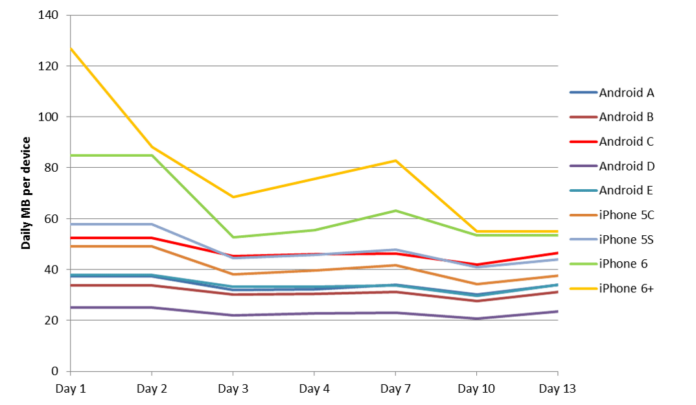Data from the early days of Apple’s iPhone 6 launch shows that the two new iPhone models are prompting an upswing in VoLTE adoption and a sharp drop in 3G voice calling, according to Newfield Wireless — and iPhone 6 users consume even more data than was being used by previous advanced devices.
Radio access network geoanalytics company Newfield Wireless is part of Tektronix Communications and is in the process of being acquired by NetScout. Newfield relied on its TrueCall platform, which assesses VoLTE delivery and performance, for the data and analysis.
Newfield looked at data from the first 13 days of the iPhone 6 and 6 Plus launch. The number of 3G calls originating on those devices was just one-fifth of the 3G calls made from previous iPhone models, the company said, adding that “U.S. networks have experienced a surge in VoLTE calls since the September launch.”
According to Newfield’s analysis, iPhone 4 users chatted via 3G between 25 and 30 minutes per day during those 13 days. iPhone 5 users used about 20-25 3G voice minutes each day in that period. But iPhone 6 users were making only about 5 minutes worth of 3G calls each day.
“The 3G voice minutes have fallen dramatically on these devices,” said Marc Bensadoun, CEO of Newfield Wireless. He noted that theoretically, people with iPhone 6s could be making fewer voice calls overall. “But I think it’s more than that,” he added. “It’s simply that many people have enabled VoLTE.”
Most LTE devices still have their voice calls carried by 2G and 3G networks, because either the devices themselves or the mobile networks aren’t yet VoLTE-capable. But VoLTE’s debut has finally come: AT&T and T-Mobile US have turned on the service in some markets, and Verizon Wireless launched its VoLTE offering, called Advanced Calling 1.0, in September on an opt-in basis on six devices, including the iPhone 6 models. VoLTE calls are not currently available for cross-carrier calls, but Verizon and AT&T announced this week that they are partnering on interoperability efforts for VoLTE.
Much testing will need to be done in order to establish VoLTE interoperability, and to iron out kinks in the service as its use becomes more widespread. Bensadoun said that with 2G and 3G service, about 70% of all customer-impacting issues have their root causes in the radio access network.
“We don’t know for a fact that that will replicate with VoLTE, but I think it’s reasonable to expect that the situation will be very similar,” said Bensadoun. He has been trying VoLTE himself, on an iPhone 6, and added that in his personal experience thus far, “I would say call set-up has been great — call retention, not so good.”
He described end-to-end VoLTE calls as sounding “a little bit like you’re in a sound studio, and that you’re very close to the other person. It’s quite a good thing, actually.”
Newfield also said in a statement on its data that the VoLTE uptake driven by the new iPhones “should act as an incentive to other manufacturers to adopt a ‘VoLTE First’ strategy and launch their own compatible devices.”
On the mobile data usage side, Newfield’s analysis showed the enormous impact of the new iPhones, particularly right after launch and especially from the iPhone 6 Plus.
On the first day the devices were available, Truecall reported iPhone 6 Plus users consuming more than 120 MB of mobile data daily per device, more than double what users on any other type of device were consuming (data-hungry iPhone 5S users were averaging about 60 MB of mobile usage data on iPhone 6 launch day). Users of iPhone 6s, meanwhile, consumed more than 80 MB of mobile data on launch day. The heaviest usage peaked on Day One and had mostly tapered off by Day Three, only to surge again on Day Seven. By Day 10 of the launch period, average data usage for both the 6 and 6 Plus had dropped just below 60 MB/day, less than half of the Day One consumption.
Newfield also concluded that the number of iPhone 6 handsets on mobile networks far outnumbers the 6 Plus (there are about five times as many active iPhone 6s as 6 Pluses), and that the majority of iPhone 6 handsets coming to mobile networks are direct replacements of the iPhone 5.
Follow me on Twitter! @khillrcr

